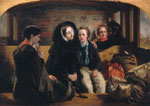Exiles and Emigrants
Education Resource
Leaving Home
During the reign of Queen Victoria (1837 to 1901) almost fifteen million people, known as emigrants left Ireland, Scotland and England, the British Isles to settle in other countries. People fled the potato famine in Ireland, the land clearances in Scotland and the agricultural revolution in England.
Potatoes were the main food source for many Irish people at this time. The potato famine lasted four years in Ireland and was caused by a disease affecting potatoes resulting in starvation and death for many people.
The Scottish land clearances resulted in many Scots being forced off their traditional land to clear the area for sheep which the landlords knew would be more profitable.
In England the rapidly developing industries encouraged people to leave the country and flock to the towns causing intense overcrowding. As a consequence these people were without work and forced to leave their homes. In search of a better life they left their country and were known as emigrants.
Exiles were convicted prisoners, under short sentence, due to be transported to the colonies. They had to undergo a period of isolation so that they could reflect on the 'evils of their former course' and convince the authorities they had the potential to reform. They then received training in trades deemed important in the colonies and they were given a royal pardon on disembarking in Australia. They could not return to Britain during the period of their original sentence.
There is an original pardon signed by Queen Victoria in the exhibition. Nine ships containing 1727 Exiles came to Victoria between 1842 and 1849. Transportation of convicts finished in 1867.
In 1833 slavery was abolished in the British Empire and in 1837 the Government established a permanent Emigration Department. In 1847 the Factory Act limited the working day for women and children aged 13 to 18 to ten hours. Gold was discovered in Australia around 1851 and this proved to be a great impetus for emigration.
- Discuss why so many people left the British Isles during the 19th century.
- Consider how the artists have created these images, comment on the use of colour, form, composition and focal point.
- Select the most interesting painting and justify your choice.






